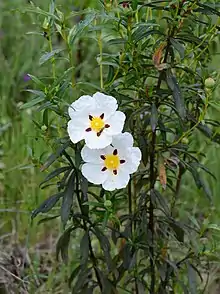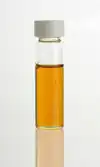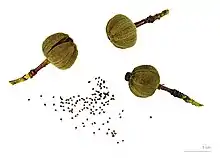Cistus ladanifer
Cistus ladanifer is a species of flowering plant in the family Cistaceae. It is native to the western Mediterranean region. Common names include gum rockrose,[1] labdanum,[1] common gum cistus,[1] and brown-eyed rockrose.[2]
| Cistus ladanifer | |
|---|---|
 | |
| Scientific classification | |
| Kingdom: | Plantae |
| Clade: | Tracheophytes |
| Clade: | Angiosperms |
| Clade: | Eudicots |
| Clade: | Rosids |
| Order: | Malvales |
| Family: | Cistaceae |
| Genus: | Cistus |
| Species: | C. ladanifer |
| Binomial name | |
| Cistus ladanifer | |
Description
It is a shrub growing 1–2.5 m (3 ft 3 in – 8 ft 2 in) tall and wide. The leaves are evergreen, lanceolate, 3–10 cm long and 1–2 cm broad, dark green above and paler underneath. The flowers are 5–8 cm diameter, with 5 papery white petals, usually with a red to maroon spot at the base, surrounding the yellow stamens and pistils. The whole plant is covered with the sticky exudate of fragrant resin, the source of labdanum, used in herbal medicine and perfumery.
Ecology
C. ladanifer is particularly well suited to the Mediterranean climate, standing both long summer droughts and cold weather. It is an extremely aggressive plant which has taken over much of former farmland and grasslands in the mountain regions of central Spain and much of southern Portugal. In Spanish it is known as Jara pringosa meaning "sticky shrub". In Portuguese it is known as "esteva". It has been found to have mycorrhizal associations with Boletus edulis, Boletus rhodoxanthus, and Laccaria laccata.[3]
Systematics
The wide distribution and morphological variation of C. ladanifer across northern Africa, the Iberian Peninsula, and southern France has resulted in the recognition of three sub-species: subspp. ladanifer, sulcatus, and africanus.
Subspecies
- C. ladanifer subsp. ladanifer — Endemic to the Iberian Peninsula, France, Morocco and the Balearic Islands.[4]
- C. ladanifer subsp. mauritianus Pau & Sennen — Endemic to Morocco, Algeria and southern Spain (Málaga Province).[5]
- C. ladanifer subsp. sulcatus Demoly, syn. C. palhinhae Ingram — Endemic to western coastal Portugal.[6][7]
Phylogeny
C. ladanifer is placed within the C. salvifolius group within the white and whitish pink flowered clade of Cistus species.[8]
| Species-level cladogram of Cistus species. | ||||||||||||||||||||||||||||||||||||||||||||||||||||||||||||||||||||||||||||||||||||||||||||||||||||||||||||||
| ||||||||||||||||||||||||||||||||||||||||||||||||||||||||||||||||||||||||||||||||||||||||||||||||||||||||||||||
| Species-level cladogram of Cistus species, based on plastid and nuclear DNA sequences.[9][10][8][11] |
Phylogenetic and divergence dating methods found that C. ladanifer diverged during the Pleistocene, long after the opening of the Strait of Gibraltar around 5 mya, which supports a hypothesis of dispersal for this species.[12] Although its seeds fall close to the maternal plant,[13] C. ladanifer may have successfully dispersed due to its preference for disturbed habitats.
Uses

It is a popular ornamental plant, grown for its strongly resin-scented foliage and conspicuous flowers. Its leaves yield a fragrant oleoresin known as labdanum, used in perfumes, especially as a fixative. (Not to be confused with "Laudanum", another name for tincture of opium).
This plant has gained the Royal Horticultural Society's Award of Garden Merit.[14]
See also
- Boletus edulis - a mushroom species with which it has a mycorrhizal association
References
- "Cistus ladanifer". Germplasm Resources Information Network. Agricultural Research Service, United States Department of Agriculture. Retrieved 4 May 2015.
- Hériteau, Jacqueline (2005). Complete Gardening in Southern Africa (2nd ed.). Creative Homeowner. p. 170. ISBN 978-1-58011-259-8.
- Águeda B, Parladé J, de Miguel AM, Martínez-Peña F (2006). "Characterization and identification of field ectomycorrhizae of Boletus edulis and Cistus ladanifer". Mycologia. 98 (1): 23–30. doi:10.3852/mycologia.98.1.23. hdl:10171/18758. PMID 16800301. Retrieved 2009-11-23.
- "Infraspecific Taxon Details : Cistus ladanifer subsp. ladanifer". Catalogue of Life. Retrieved 24 November 2020.
- "Infraspecific Taxon Details : Cistus ladanifer subsp. mauritianus Pau & Sennen". Catalogue of Life. Retrieved 24 November 2020.
- "Infraspecific Taxon Details : Cistus ladanifer subsp. mauritianus Pau & Sennen". Catalogue of Life. Retrieved 24 November 2020.
- "Cistus ladanifer subsp. sulcatus (Demoly) P.Monts". Flora-on. Retrieved 24 November 2020.
- Guzman, B.; Lledo, M.D. & Vargas, P. (2009). "Adaptive Radiation in Mediterranean Cistus (Cistaceae)". PLOS ONE. 4 (7): e6362. Bibcode:2009PLoSO...4.6362G. doi:10.1371/journal.pone.0006362. PMC 2719431. PMID 19668338.
- Guzmán, B. & Vargas, P. (2005). "Systematics, character evolution, and biogeography of Cistus L. (Cistaceae) based on ITS, trnL-trnF, and matK sequences". Molecular Phylogenetics and Evolution. 37 (3): 644–660. doi:10.1016/j.ympev.2005.04.026. PMID 16055353.
- Guzmán, B. & Vargas, P. (2009). "Historical biogeography and character evolution of Cistaceae (Malvales) based on analysis of plastid rbcL and trnL-trnF sequences". Organisms Diversity & Evolution. 9 (2): 83–99. doi:10.1016/j.ode.2009.01.001.
- Civeyrel, Laure; Leclercq, Julie; Demoly, Jean-Pierre; Agnan, Yannick; Quèbre, Nicolas; Pélissier, Céline & Otto, Thierry (2011). "Molecular systematics, character evolution, and pollen morphology of Cistus and Halimium (Cistaceae)". Plant Systematics and Evolution. 295 (1–4): 23–54. doi:10.1007/s00606-011-0458-7. S2CID 21995828.
- Guzmán, B. and P. Vargas. 2009. Long-distance colonization of the Western Mediterranean by Cistus ladanifer (Cistaceae) despite the absence of special dispersal mechanisms. Journal of Biogeography 36:954-968.
- Bastida, F. and S. Talavera. 2002. Temporal and spatial patterns of seed dispersal in two Cistus species (Cistaceae). Annals of Botany 89:427-434.
- "Cistus ladanifer L." Royal Horticultural Society. Archived from the original on 24 December 2012. Retrieved 19 May 2017.
External links
Databases
- Cistus ladanifer in the CalPhotos photo database, University of California, Berkeley
- "Cistus ladanifer". Calflora. Berkeley, California: The Calflora Database.
- "Cistus ladanifer". Plants for a Future.
